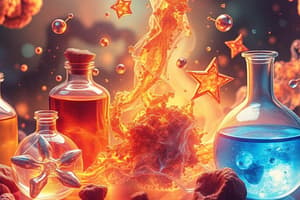Podcast
Questions and Answers
Describe the two kinds of pure substances. How do these differ from mixtures?
Describe the two kinds of pure substances. How do these differ from mixtures?
The two kinds of pure substances are elements and compounds. Pure substances differ from mixtures in that mixtures are combinations of two or more substances that are not chemically combined.
What is matter and where did it come from?
What is matter and where did it come from?
Matter is anything that occupies space and has mass. All matter was created during the events of Creation Week when it was spoken into existence by God.
Differentiate between physical and chemical properties of matter. Give two examples of each property.
Differentiate between physical and chemical properties of matter. Give two examples of each property.
A physical property can be determined without altering the chemical composition, examples include color and hardness. A chemical property can be determined only through a change that alters its composition, examples include combustion and decomposition.
What is a physical change? Give three examples of physical changes.
What is a physical change? Give three examples of physical changes.
What kind of change does shot peening cause in a sheet of metal? Why is it that type of change?
What kind of change does shot peening cause in a sheet of metal? Why is it that type of change?
What property of metal does shot peening use?
What property of metal does shot peening use?
How is shot peening an example of using technology to exercise dominion and to love your neighbor as yourself?
How is shot peening an example of using technology to exercise dominion and to love your neighbor as yourself?
What are the two main classes of matter and what characteristics differentiate them?
What are the two main classes of matter and what characteristics differentiate them?
Explain the difference between heterogeneous and homogeneous mixtures.
Explain the difference between heterogeneous and homogeneous mixtures.
Flashcards are hidden until you start studying
Study Notes
Pure Substances vs. Mixtures
- Pure substances consist of only one type of atom (element) or one type of compound.
- Mixtures are combinations of two or more substances that are not chemically bonded.
Matter and Its Origin
- Matter occupies space and has mass.
- All matter originated during Creation Week, spoken into existence by God.
Physical vs. Chemical Properties
- Physical Properties: Can be observed without changing the substance's composition (e.g., color, hardness, electrical conductivity, malleability).
- Chemical Properties: Only observable through a change that alters the substance's composition (e.g., combustion in oxygen, decomposition with electric current).
Physical Change
- A physical change involves rearrangement of particles without altering their composition.
- Examples include crushing, dissolving, hammering, or state changes.
Shot Peening in Metals
- Shot peening is a physical change as it does not alter the substance of the metal.
- It utilizes the malleability of metal to enhance strength.
Technological Application of Shot Peening
- Shot peening serves to reduce risk of loss, expenses, and natural resource exploitation, showcasing responsible stewardship.
Classes of Matter
- Matter is classified into two main types: pure substances and mixtures.
- Pure substances are chemically combined; mixtures are physical combinations of substances.
Heterogeneous vs. Homogeneous Mixtures
- Heterogeneous Mixtures: Contain distinct pieces or regions (e.g., granite).
- Homogeneous Mixtures: Have uniform distribution of particles (e.g., salt water).
Studying That Suits You
Use AI to generate personalized quizzes and flashcards to suit your learning preferences.




